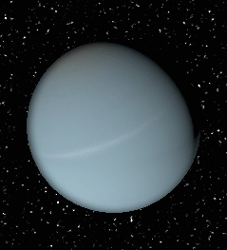

-
Uranus is the seventh planet from the Sun. While being visible to the naked eye, it was not recognized as a planet due to its dimness and slow orbit. Uranus became the first planet discovered with the use of a telescope. Uranus is tipped over on its side with an axial tilt of 98 degrees. It is often described as “rolling around the Sun on its side.”
-
To date 27 moons have been discovered around Uranus, those named after characters from Shakespeare include Titania (A Midsummer Night’s Dream), Oberon (A Midsummer Night’s Dream), Ariel (The Tempest), Miranda (The Tempest) and Puck (A Midsummer Night’s Dream).

-
Miranda is the smallest of the rounded satellites of Uranus. It also orbits the closest of the five larger moons. It is named after one of the characters in Shakespeares play, “The Tempest”. It was also featured in Arthur C. Clark’s novel “2001: A Space Odyssey”.
-
Miranda was discovered in 1948 by astronomer Gerard Kuiper. The Kuiper Belt of the outer solar system is named for him.
-
Miranda is made largely of ice with some rocky material closer to its centre.
-
Titania is Uranus’ largest moon and is the eighth largest moon in the solar system. Like many of Uranus’ moons it is named after a character of William Shakespeare. Titania was discovered by William Herschel in 1787 the same day he discovered Oberon, another of Uranus’ moons.
Diameter: 1,577.8 km
Mass: 3.42 × 10^21 kg (4.7% Moon)
Orbits: Uranus
Orbit Distance:436,300 km
Orbit Length: 8.7 days
Surface Temperature: -203 °C
Discovery Date: January 11, 1787
Discovered By: William Herschel

Uranus Diagram
Facts about Uranus
-
Uranus was officially discovered by Sir William Herschel in 1781.
-
Uranus turns on its axis once every 17 hours, 14 minutes.
-
The planet rotates in a retrograde direction, opposite to the way Earth and most other planets turn.
-
Uranus makes one trip around the Sun every 84 Earth years.

MORE URANUS FACTS
-
Uranus is often referred to as an “ice giant” planet.
Like the other gas giants, it has a hydrogen upper layer, which has helium mixed in. Below that is an icy “mantle, which surrounds a rock and ice core. The upper atmosphere is made of water, ammonia and the methane ice crystals that give the planet its pale blue colour. -
Uranus hits the coldest temperatures of any planet.
With minimum atmospheric temperature of -224°C Uranus is nearly coldest planet in the solar system. While Neptune doesn’t get as cold as Uranus it is on average colder. The upper atmosphere of Uranus is covered by a methane haze which hides the storms that take place in the cloud decks. -
Uranus has two sets of very thin dark coloured rings.
The ring particles are small, ranging from a dust-sized particles to small boulders. There are eleven inner rings and two outer rings. They probably formed when one or more of Uranus’s moons were broken up in an impact. The first rings were discovered in 1977 with the two outer rings being discovered in Hubble Space Telescope images between 2003 and 2005. -
Uranus’ moons are named after characters created by William Shakespeare and Alexander Pope.
These include Oberon, Titania and Miranda. All are frozen worlds with dark surfaces. Some are ice and rock mixtures. The most interesting Uranian moon is Miranda; it has ice canyons, terraces, and other strange-looking surface areas. -
Only one spacecraft has flown by Uranus.
In 1986, the Voyager 2 spacecraft swept past the planet at a distance of 81,500 km. It returned the first close-up images of the planet, its moons, and rings.